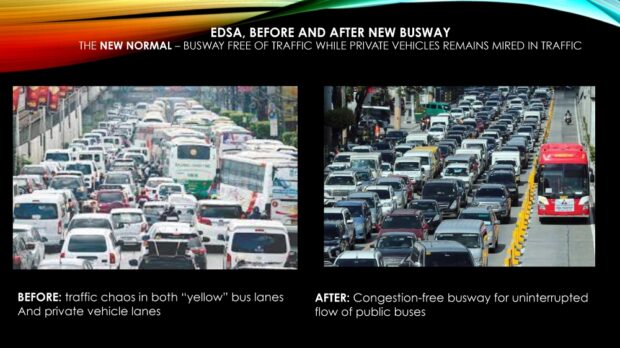
For decades, Metro Manila acquired the ignominious distinction as a megacity with monstrous traffic congestion and unreliable public transportation. Thousands of buses and jeepneys were operating—with or without government-issued franchises—in whichever fashion, oblivious to traffic rules. On good weather days, they jammed the streets. But whenever rain pours, they would be scarce and leave hapless commuters stranded on the streets. Daily gridlock and transportation woes raised doubts on whether Metro Manila’s mobility problems will ever be solved.
Epifanio delos Santos Avenue, or Edsa, being the most commuter-dense corridor, was ground zero of this long-running urban malady. Over 3,000 buses jammed in gridlock, spilling over from the designated two outermost bus corridors to the adjoining lanes for private vehicles, which by themselves were mired in bumper-to-bumper traffic. The traffic mess on Edsa contributed greatly to the estimated daily economic losses of over P3 billion in Metro Manila.
Relief came in June 2020 when structural bus transportation reforms were instituted, providing a sustainable commuter-friendly and efficient alternative traffic-free all-weather bus system with less air pollution. But the remarkable gains will be negated by the clamor of certain quarters to revert to the defunct so-called yellow bus lanes at the curbside and for the return of over 3,000 buses. There are also attempts by motorists to use the busway, which is supposed to be dedicated to public buses.
The COVID-19 pandemic lockdown starting in March 2020 provided the opportunity for a strong-willed national administration to institute reforms urged by private sector advocates. The single-lane busway was introduced on Edsa in June 2020 by the transportation department then headed by Sec. Arthur Tugade at the innermost lane adjacent to the MRT 3 tracks that replaced the inefficient two outermost bus lanes. Franchises were reorganized to rationalize bus service and the Edsa Carousel Line was introduced with a consortium of operators fielding no more than 550 buses, while buses on feeder routes were not allowed on Edsa. Admirably, the bus operators cooperated and bought into the new bus operating system.
Thereafter, a new normal was ushered in Edsa. The new busway and carousel Line, together with the rehabilitated MRT 3 elevated light train, provided commuters with a more reliable and faster commute on the Edsa trunk line. In stark contrast, private vehicles remain mired in traffic despite the roadway being expanded to four lanes in each direction. This situation proved once again the principle of induced demand as the widened road attracted additional vehicles that overwhelmed its capacity in no time.
Reversion to the past bus system will amount to policy backsliding and, if granted, will be very detrimental to both bus operators, commuters, economy and the environment. In addition to this reason, the Management Association of the Philippines (MAP) opposes the change in the existing inner lane alignment of the busway to the curbside as it would violate a fundamental busway standard, which is the most important factor for its efficiency.
This new busway has proven to be the most cost-effective urban mass transit system. Although still a work in progress, the busway carried a one-day peak load of 454,649 passengers on Dec. 27, 2022 with no more than 550 bus units running on just one innermost busway. Average daily ridership reached 380,378 in Dec. 2022 during the heavy postlockdown Christmas season. Total ridership reached 154,100,856 since its introduction in June 2020 up to Dec. 2022. Capital expenditures by the national government reached no more than P1 billion, excluding the rolling stock. This translates to the lowest capital cost-to-passenger ratio of any transit system, including rail.
Additionally, system and order have been restored. Commuters’ travel time was cut by more than half, allowing them to be more productive at work and enjoy quality time with their families. The more efficient busway has also facilitated travel for ambulances and emergency vehicles. On the other hand, the yellow bus lanes failed because they were located at the traffic conflict curbside lanes. Bus flow was disturbed by private vehicles turning in and out to the many side streets. Nonaccredited buses were able to infiltrate the bus corridor due to absence of access control.
The busway is a mature transit concept, having been introduced abroad over 50 years ago and proven as a better alternative to the curbside bus lanes. Busways follow globally accepted standards and best practices, chief among them being the alignment away from the traffic conflict curbside. Another is that the busway must be dedicated for exclusive use of public buses with no mixed traffic allowed. These nondiscretionary features and best practices, which became part of the bus rapid transit system (BRT), were the compelling reasons for this author to advocate the introduction of the busway as replacement for the yellow bus lanes.
MAP earnestly urges the Department of Transportation to stay the course and expedite the completion of this busway project, preferably in partnership with a private concessionaire, and upgrade it to a BRT system. Cooperation of all concerned is needed for this BRT to progressively attain gold standard rating. This achievement will be a big boost for Metro Manila. INQ

